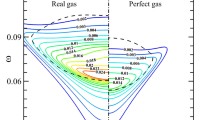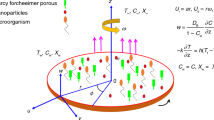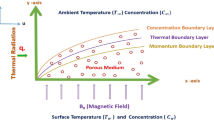Abstract
The temperature field of starting thermal plumes were measured in a rotating annulus with various rotation rates and buoyancies. The experiments revealed many details of the internal structure of these convective phenomena and also significant horizontal displacements from their source. Measurements show an increase in the maximum temperature observed in the thermal caps with increasing rotation and a more rapid cooling of the buoyancy source.
Similar content being viewed by others
Abbreviations
- D :
-
angle relating inward centripetal acceleration to buoyant acceleration, defined by tan D = RΩ/g
- g :
-
gravitational acceleration
- P :
-
total pressure of ambient fluid
- R :
-
radial coordinate measured from rotation axis
- R 0 :
-
distance from rotation axis to buoyancy source
- u :
-
velocity of fluid parcel along the radial direction
- ν:
-
velocity of fluid parcel along the azimuthal direction
- w :
-
velocity of fluid parcel along the axial direction
- z :
-
axial coordinate, measured upward from the plane containing the buoyancy source
- ϱ:
-
density of a buoyant parcel of fluid
- ϱ0 :
-
density of the ambient fluid
- θ:
-
azimuthal angle measured from the radial line passing through the buoyancy source
- Ω:
-
rotation rate of the R−θ−z coordinate system in radians/second
References
Annamalai, P.; Subramanian, R. S.; Cole, R. 1982: Bubble migration in a rotating, liquid-filled sphere. Phys. Fluids 25, 1121–1126
Burch, J. 1983: An experimental study of the effects of solid body rotation on buoyant thermals. Master's Thesis, Rutgers University
Busse, F. H. 1982: Convection in rotating systems. Proceedings of the Ninth U.S. National Congress of Applied Mechanics, pp. 299–306
Cerasoli, C. P. 1974: Experiments with a rotating source-sink annulus. Ph.D. Thesis, Rutgers University
Morton, B. R.; Taylor, G. I.; Turner, J. S. 1956: Turbulent gravitational convection from maintained and instantaneous sources. Proc. Roy. Soc. London A234, 1–23
Müller, M R.; Burch, J. N. 1983: A micro-computer controlled experimental study of isolated convection in a rotating annulus. Proceedings of the Intern. Conf. on the Use of Micros in Fluids Engineering, BHRA, 95–106
Shlien, D. J.; Boxman, R. L. 1981: Laminar starting plume temperature field measurement. Heat and Mass Transfer 24, 919–931
Shlien, D. J.; Thompson, D. W. 1975: Some experiments on the motion of an isolated laminar thermal. J. Fluid Mech. 72, 35–44
Turner, J. S. 1962: The ‘starting plume’ in neutral surroundings. J. Fluid Mech. 13, 356–368
Wilkins, E. M.; Sasaki, Y.; Friday, E. W.; McCarthy, J.; McIntyre, J. R. 1969: Properties of simulated thermals in a rotating fluid. J. Geophys. Res. 74,4472–4486
Wilkins, E. M.; Sasaki, Y.; Johnson, H. L. 1975: Surface friction effects on thermal convection in a rotating fluid: A laboratory simulation. Mon. Weather Rev. 103, 305–317
Wilkins, E. M.; Sasaki, Y.; Marion, E. W. 1972: Laboratory simulation of wake effects on second and third thermals in a series. Mon. Weather Rev. 100, 399–407
Wilkins, E. M.; Sasaki, Y.; Schauss, R. H. 1971: Vortex formation by successive thermals: a numerical simulation. Mon. Weather Rev. 99, 577–592
Author information
Authors and Affiliations
Rights and permissions
About this article
Cite this article
Müller, M.R., Burch, J.N. An experimental study of the behavior of transient isolated convection in a rigidly rotating fluid. Experiments in Fluids 3, 17–23 (1985). https://doi.org/10.1007/BF00285266
Received:
Issue Date:
DOI: https://doi.org/10.1007/BF00285266




